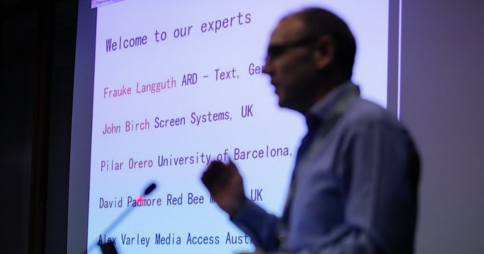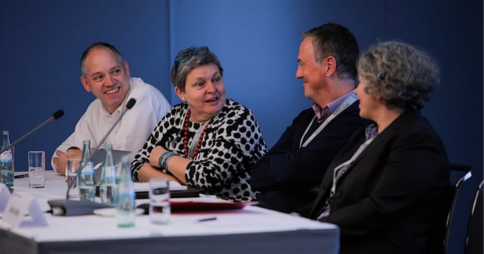
Led by Media Access Australia CEO Alex Varley, the five panellists at the conference covered a wide range of topics, fed by comments and questions from the audience and pre-conference opinions from across the world. It is impossible to distil 90 minutes of robust, lively discussion, but here are 20 thoughts/ideas and insights from the panel broken up into a few themes.
Technology will make it all easier
1. Technology will be customised and set to a ‘user preference’ so that it will automatically select captions, audio description, voice menus and other features for the person using the device at that time.
2. The work on technical standards to ensure that access features can move across different content and different platforms will be practically completed. There should be no technical barriers to access following content.
3. In some non-English speaking language countries with small populations, limitations in software and technology will mean that some access services, such as audio description, may only be delivered online (not broadcast) using HBB technology or online streaming.
4. Customisation whereby the device recognises the language/other information about the content and provides the captions, description, voice menus in that language. This will be very popular in multilingual countries with a very mixed population (such as in the Middle East).
5. Automation will have limited impact on audio description, mainly confined to the AD narration being synthetic, but meaningful automatic video recognition and description is way beyond any computer capability and will remain that way for decades.
The access industry will keep growing and evolving
6. Access companies will compete on the ability to monetise and add-value to content via captions, description and other data inclusion.
7. Access will expand as other uses and users are found for captioning (helping people on the autism spectrum, non-native language speakers, search engine optimisation, real-time streaming text services) and audio description (people with language processing issues, video cataloguing).
8. Competition across international boundaries, such as video on demand services, will ensure that access is delivered as part of this to ensure that revenue can be maximised.
9. The big growth areas for access services will be Asia and the Middle East, especially as language and presentation standards are standardised (e.g. spoken Arabic for description).
10. Captioners will do very little captioning and spend more time editing automatically produced captions and adding in extra data to help, except on live programs which will still need direct human input.
11. Follow the money. Access is all about how you can use captions and description to better search, catalogue, personalise and add value to video content. Disability access is (almost) a flow-on.
Consumers
12. Consumers will use many devices and choose and consume content from wherever and at a time that suits them. Access forms part of the content.
13. Consumer advocacy movement will become bigger as the ageing population peaks and there will be more collaboration across borders reflecting how content is produced and organised.
14. There will be more access and choice as access will be on all media, screens and wherever you need information – parks, venues, household appliances, schools, transport.
Standards and regulations
15. Caption quality will be standardised even further and users will be able to choose font size, colours and other features through their viewing device.
16. Audio description quality and standardising how content is described will be made more consistent, but there will still be disagreements.
17. Access regulation will remain for traditional services that are licensed, such as broadcast television, but won’t apply to the complex range of other ways of delivering content as regulators simply won’t be able to keep up. Instead the move will be to regulate content itself to ensure that it is accessible.
18. The European Commission government has already predicted the future and mapped out its priorities and areas of interest for the next five years in Horizon 2020. A major contribution is that ‘accessibility’ is an old-fashioned term. It will be about “new audiences”.
Some things will never change
19. Companies will keep releasing apps (especially crowdsourcing technology) and devices (with big buttons and only available in black) that claim to solve access problems. Consumers will get all excited and then realise that they don’t work that well after all and go back to the mainstream technology.
20. Some people will continue to watch only television services using a television sitting in the corner of the living area at home. Most of these people will need and (mainly) use access services.

Thanks to the experts:
- John Birch – Strategic Partnerships Manager, Screen Systems, UK
- Pilar Orero – Head of Research a the CAIAC Research Centre, University of Barcelona, Spain
- David Padmore – Director of Access Services, Red Bee Media, UK
- Frauke Langguth – Head of ARD Text at Rundfunk Berlin-Brandenburg, Germany
Top of page

